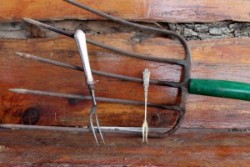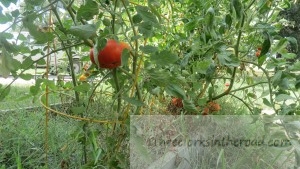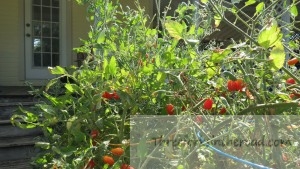Hot Tomato! Growing tomatoes in hot weather
Tomatoes don’t produce in the heat.
Wanna bet? Well, I would have bet against you until the last two years. Coming from the Midwest, I knew tomato plants to produce fruit in the warmer months, but once it got hot (90+) fuhgettaboutit.
Then I moved to Texas.
Growing things in Texas is only like growing things in Ohio in that you plant things in the ground, otherwise the timing, the plants, the way you water and fertilize, pretty much everything is different.
I’ve been trying to grow the productive tomato plants I enjoyed in Ohio for years now, and only in the last couple have I landed on varieties and watering/planting techniques that seem to be working. See?
First, for big tomatoes. Variety: Heatmaster. I’ve tried a lot of other so-called heat resistant varieties, and they might grudgingly produce a tomato or two after a couple of weeks of 90-100 degree temps, but no other variety deliveries the goods like Heatmaster. I’ve both direct seeded and planted from seedlings with success.
Second, for grape tomatoes. Variety: Tami G. Grows like a weed (in a good way) and produces, produces, produces sweet, delicious grape tomatoes in abundances. So far only planted from seedling, but will direct sow next year and see what happens.
Third, cherry tomatoes. Variety: Sun Gold. Delicious, sweet, small yellow cherry size tomatoes. The downside is that the plants willingly hybridize to their detriment. These will volunteer year after year, but pull them and replant from seed or seedling.
Both the Tami G and the Sun Golds can get long and leggy, but they still produce. I stake them as much as I can, but if they get too long I just drape them over adjoining tomato frames.
Growing techniques. I grow in raised beds so I can control the soil mix. Although we’ve got some pretty nice soil here in Central Texas, it is inconsistent, and with all the running grass varieties I just find raised beds easier to manage. My most productive plants are on the north side of the house, which to you Midwest gardeners makes no sense. But the afternoon shade given by the house seems to be just want the tomatoes want after the full brunt of the sun all day.
Fertilizing. I rework the soil in my raised beds each year, adding composted manure, peat, and good ol’ Miracle Grow Shake n Feed for vegetables. I fertilize with the Shake n Feed about every three months.
Watering. I flood the beds a couple times a week. Think rice paddy. Soak it, sog it, have the water standing when you’re done. Then leave it alone for a few days and do it again. Nature taught me this in this years heavy rains here, I’ve continued it and it’s working (and much less work than either a drip system (which also works well but can be expensive) or showing the beds every day. Every. Day.
So there. Good luck growing your tomatoes in the heat. Tomorrow night it’s caprese salad with fresh tomatoes, basil and homemade mozzarella. Homemade mozzarella you say? Stay tuned…


